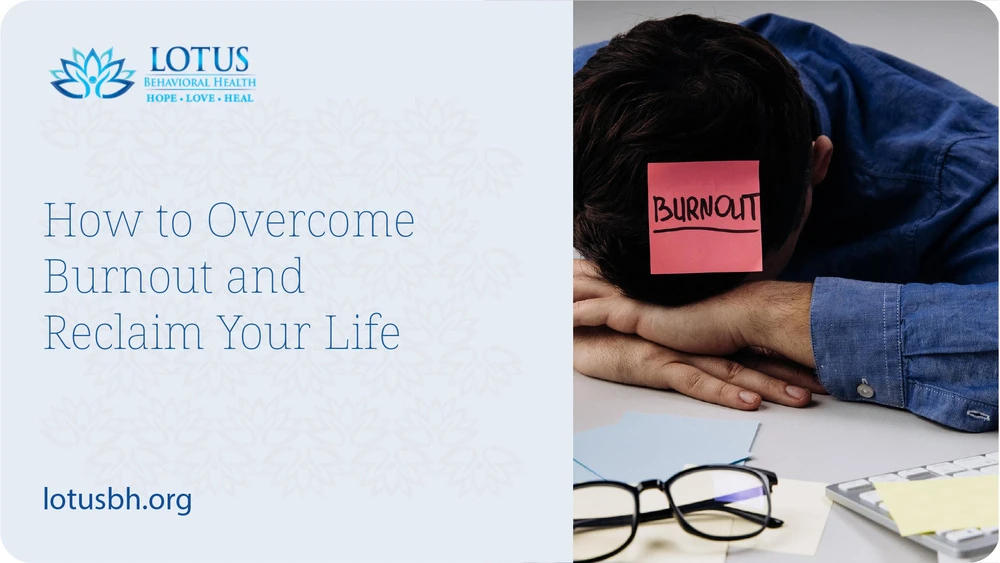How to Overcome Burnout and Reclaim Your Life
Break free from burnout and reclaim your life! Discover strategies to overcome burnout and find balance.
Understanding Burnout

In order to overcome burnout, it is important to first understand what it is and its underlying causes. Burnout is a state of emotional, physical, and mental exhaustion caused by excessive and prolonged stress. It occurs when individuals feel overwhelmed, emotionally drained, and unable to meet constant demands [1]. While burnout is often associated with work-related stress, it can also happen in other areas of life, affecting one's overall health.
Definition and Causes
Burnout is characterized by emotional exhaustion, attitudinal hardening, and a sense of decreased accomplishment, which can lead to mental health problems such as depression or psychosomatic disorders. It can result in decreased productivity, increased sick leave, and potential early retirement for affected individuals [3].
The causes of burnout are multifactorial, but they primarily stem from high efforts (time, emotional involvement, empathy), poor satisfaction, and stressful working conditions with high demands. Certain professions, such as nurses, physicians, social workers, teachers, and similar helping professions, are particularly susceptible to burnout [3]. It is important to note that burnout is unique to each individual, influenced by factors such as personality traits and past work experiences.
Signs and Symptoms
Recognizing the signs and symptoms of burnout is crucial for early intervention and prevention. Some common signs and symptoms of burnout include:
- Physical and emotional exhaustion
- Feelings of cynicism or detachment from work
- Reduced productivity and effectiveness
- Increased irritability and negative outlook
- Physical symptoms such as headaches, fatigue, and gastrointestinal issues
- Difficulty concentrating or maintaining focus
- Withdrawal from social activities and relationships
It is important to note that burnout shares some overlapping symptoms with depression; however, burnout is primarily linked to work-related stress and does not meet the clinical criteria for depression [4].
By understanding the definition and causes of burnout, as well as recognizing its signs and symptoms, individuals can take proactive steps to address and overcome burnout. In the following sections, we will explore the impact of burnout, different types of burnout, recovery strategies, and burnout prevention techniques.
Impact of Burnout

Experiencing burnout can have significant effects on both the emotional and physical well-being of individuals. It can also have implications for their relationships and work life.
Emotional and Physical Effects
Burnout can provoke feelings of helplessness, cynicism, and resentment, which can lead to emotional exhaustion [5]. Individuals may feel overwhelmed, emotionally drained, and unable to cope with the demands placed upon them. These emotional effects can manifest as irritability, mood swings, and a decreased sense of accomplishment.
The long-term impact of burnout can extend to physical health. Research has shown that burnout can increase vulnerability to illnesses such as colds and flu. The chronic stress associated with burnout can weaken the immune system, making individuals more susceptible to infections and other health issues. It is essential to address burnout to prevent its negative effects on overall well-being.
Relationship and Work Implications
Burnout not only affects individuals personally but also has implications for their relationships and work life. Feelings of cynicism and resentment can strain personal relationships, leading to conflicts and a decreased sense of connection with others. Burnout can make individuals feel emotionally distant, leading to difficulties in maintaining healthy and fulfilling relationships.
In the workplace, burnout can have detrimental effects. It can result in decreased productivity, increased sick leave, and potential early retirement for affected employees. The symptoms of burnout, such as emotional exhaustion and decreased motivation, can impact job performance and satisfaction. Burnout can also lead to a sense of detachment and disengagement from work, which can further exacerbate the negative consequences.
Employers and organizations play a crucial role in addressing and preventing burnout. By creating a supportive work environment that values work-life balance and provides resources for stress management, employers can help mitigate the impact of burnout on their employees' well-being and overall productivity.
Understanding the emotional and physical effects of burnout, as well as its implications for relationships and work, is essential in recognizing the signs and taking steps towards recovery and prevention. By prioritizing self-care, seeking support, and implementing strategies to manage stress, individuals can overcome burnout and reclaim their lives. For more information on burnout prevention, refer to our article on work-life balance and stress management.
Differentiating Burnout and Depression
When it comes to mental health, it's important to understand the differences between burnout and depression. Although burnout and depression can share some symptoms and have overlapping effects, they are distinct conditions that require different approaches for treatment and management.
Key Differences
Burnout and depression have some important distinctions that set them apart from each other. Burnout is primarily related to work or occupational stress, while depression can be caused by various factors and is not limited to work-related issues. Burnout is characterized by feeling empty, mentally exhausted, and lacking motivation, while depression involves feelings of sadness, hopelessness, and a sense of overall despair.
Another key difference is the response to rest and time off. Burnout can often be eased by taking breaks, engaging in self-care activities, and making changes to work routines or environments. On the other hand, depression typically requires therapy or medication for effective treatment. Not addressing burnout may increase the risk of developing depression [2].
Overlapping Symptoms
While burnout and depression have distinct characteristics, there are some symptoms that can overlap between the two conditions. These shared symptoms can make it challenging to differentiate between burnout and depression. Some of the common overlapping symptoms include:
- Fatigue and low energy levels
- Sleep disturbances, such as insomnia or excessive sleep
- Cognitive difficulties, such as difficulties with concentration and memory
- Feelings of irritability or frustration
- Withdrawal from activities or social interactions
- Physical symptoms, such as headaches or gastrointestinal issues
If you are experiencing these symptoms, it is important to consult with a healthcare professional who can provide an accurate diagnosis and appropriate treatment plan. Seeking professional help can help determine whether you are dealing with burnout, depression, or a combination of both.
Understanding the differences between burnout and depression is vital for identifying the appropriate steps towards recovery. While burnout can often be managed and overcome with self-care, rest, and implementing effective stress management strategies, depression may require professional intervention. Seeking support from healthcare professionals and implementing healthy coping mechanisms is crucial in addressing and managing both conditions effectively.
Types of Burnout
Understanding the different types of burnout is essential in identifying and addressing the specific challenges individuals may face. Burnout can manifest in various ways, including overload burnout, under-challenged burnout, and neglect burnout.
Overload Burnout
Overload burnout occurs when individuals experience an overwhelming amount of work and responsibilities without adequate support or resources to manage the demands. This type of burnout often affects professions with high demands and intense work environments, such as healthcare professionals, teachers, and social workers [3]. The constant pressure and excessive workload can lead to emotional exhaustion and a sense of being physically and mentally drained.
Under-Challenged Burnout
Under-challenged burnout arises when individuals feel unstimulated or unfulfilled in their work. This type of burnout is common when individuals are not sufficiently engaged or do not find their tasks meaningful or challenging enough. It can occur when individuals are not given opportunities for growth, advancement, or creativity in their roles. Under-challenged burnout can lead to feelings of boredom, disengagement, and a lack of motivation.
Neglect Burnout
Neglect burnout occurs when individuals neglect their own self-care needs and prioritize external demands over their well-being. This type of burnout often stems from a lack of boundaries, both in personal and professional life. Neglecting self-care can lead to chronic exhaustion, as individuals fail to replenish their energy and neglect their physical, emotional, and mental well-being. Prioritizing self-care and setting boundaries is crucial in preventing neglect burnout.
Recognizing the specific type of burnout one may be experiencing is the first step towards addressing and overcoming it. By understanding the underlying causes and symptoms of each type, individuals can develop targeted strategies to alleviate burnout and regain a sense of balance and well-being. In the next sections, we will explore strategies for recovery and prevention to help individuals overcome burnout and reclaim their lives.
Recovery Strategies
When it comes to overcoming burnout and reclaiming your life, implementing effective recovery strategies is crucial. Two key strategies that can make a significant difference are setting boundaries and practicing self-care.
Setting Boundaries
Setting boundaries is essential for managing stress and preventing burnout. It involves establishing personal limits and communicating your needs and expectations to others. By setting boundaries, you can prevent an unmanageable workload and create a healthier work-life balance.
To effectively set boundaries, consider the following tips:
- Prioritize: Determine your priorities and focus on tasks that align with your goals and values. Learn to say no to additional responsibilities that may overload you.
- Communicate: Clearly communicate your availability and limitations to your colleagues and loved ones. Let them know when you need uninterrupted time for rest or self-care.
- Delegate: Don't be afraid to delegate tasks or seek support from others. Delegating responsibilities can help prevent burnout and create a sense of shared responsibility.
- Protect your personal time: Set aside dedicated time for relaxation, hobbies, and spending time with loved ones. Avoid allowing work or other obligations to encroach on this time.
By setting and maintaining boundaries, you can regain control over your time and reduce the risk of burnout. For more information on preventing burnout, consider reading our article on stress management.
Practicing Self-Care
Practicing self-care is essential for recharging and recovering from burnout. Taking charge of your physical and mental health is key to rebuilding resilience and preventing future burnout episodes.
Here are some self-care practices you can incorporate into your routine:
- Physical well-being: Prioritize activities that support your physical health, such as eating a balanced diet, staying hydrated, getting regular exercise, and getting enough sleep. Taking care of your body can improve your energy levels and overall well-being.
- Emotional well-being: Engage in activities that bring you joy and help you relax. This can include hobbies, spending time in nature, practicing mindfulness or meditation, journaling, or seeking support from a therapist or counselor.
- Time for yourself: Carve out time each day for activities that recharge you, whether it's reading a book, taking a bath, listening to music, or pursuing a creative outlet. Prioritize self-reflection and self-care to replenish your energy.
- Social support: Seek connection with loved ones and engage in meaningful relationships. Surrounding yourself with supportive and understanding individuals can provide a sense of belonging and emotional support.
Remember, self-care is not selfish; it is necessary for your well-being. By prioritizing self-care, you can restore balance, reduce stress, and prevent burnout. For additional strategies to support your recovery, consider exploring our article on recovery from burnout.
Implementing these recovery strategies, such as setting boundaries and practicing self-care, can help you overcome burnout and reclaim control over your life. It's important to remember that everyone's journey to recovery is unique, so feel free to explore different strategies and find what works best for you.
To explore additional services covered by Ambetter Insurance and other related topics, check out articles on Stages of Changes in Addiction, How many Beers it Takes to Get Drunk? , Drugs and Heart Enlargement, and Ambetter Rehab Coverage.
Burnout Prevention

Preventing burnout is essential for maintaining overall well-being and ensuring long-term productivity. By focusing on stress management and maintaining a healthy work-life balance, individuals can proactively address burnout and protect their mental and physical health.
Stress Management
Recognizing and responding to signs of stress is crucial in preventing burnout. Stress can manifest as a biological response to demanding situations, and learning to recognize the body's signals can help individuals take action to prevent chronic stress. Some effective strategies for stress management include:
- Mindfulness Practices: Mindfulness practices, such as moment-to-moment awareness, have been shown to reduce stress and anxiety. These practices enhance self-care, well-being, attention, concentration, self-awareness, and self-regulation. Engaging in mindfulness techniques, such as deep breathing exercises or meditation, can help individuals manage stress and promote a sense of calm.
- Seeking Professional Support: Burnout can provoke feelings of helplessness and can also contribute to feelings of depression. It is important to talk with a therapist or mental health professional if you are experiencing these symptoms. They can provide guidance and support in developing effective coping mechanisms and strategies for stress management.
- Recognizing Work-Related Causes: Various work-related factors can contribute to burnout, including lack of control, unclear job expectations, dysfunctional workplace dynamics, extremes of activity, and high demands. It is important to identify and address any work-related causes that may be contributing to stress. This may involve setting boundaries, communicating effectively with colleagues and supervisors, and seeking support from HR or management if necessary.
Work-Life Balance
Developing a healthy work-life balance is key to managing work and personal life effectively, which in turn helps prevent burnout. Striking a balance allows individuals to feel more motivated and energized, ultimately leading to increased productivity and job satisfaction. Consider the following strategies to promote work-life balance:
- Prioritizing Self-Care: Prioritizing self-care activities such as maintaining a balanced diet, staying hydrated, getting enough sleep, and engaging in activities that bring joy can help individuals manage stress and improve their energy levels. Taking breaks throughout the workday and engaging in hobbies or activities outside of work can contribute to overall well-being.
- Setting Boundaries: Setting clear boundaries between work and personal life is crucial for maintaining work-life balance. Establishing designated work hours, avoiding work-related activities outside of those hours, and learning to say no to excessive work demands can help create a healthier balance. It is important to communicate these boundaries with colleagues and supervisors to ensure they are respected.
- Establishing a Daily Routine: Creating a structured daily routine can help individuals maintain a sense of balance and control. Allocating specific time slots for work, personal activities, exercise, and relaxation can help ensure that each aspect of life receives adequate attention. Maintaining a routine also promotes better time management and reduces the likelihood of feeling overwhelmed.
By implementing effective stress management techniques and prioritizing work-life balance, individuals can reduce the risk of burnout and foster a healthier, more sustainable approach to work and life. It is important to remember that self-care and personal well-being are essential for long-term success and overall happiness.
References
- https://www.helpguide.org/articles/stress/burnout-prevention-and-recovery.htm
- https://www.webmd.com/mental-health/burnout-symptoms-signs
- https://pubmed.ncbi.nlm.nih.gov/8279188
- https://www.mayoclinic.org/healthy-lifestyle/adult-health/in-depth/burnout/art-20046642
- https://www.healthline.com/health/mental-health/burnout-recovery
- https://www.ncbi.nlm.nih.gov/pmc/articles/PMC9924360/
- https://www.medicalnewstoday.com/articles/preventing-burnout














.svg)








